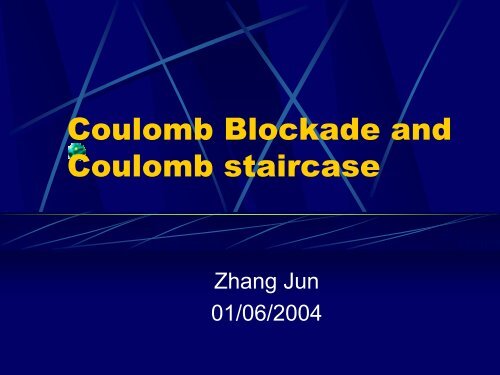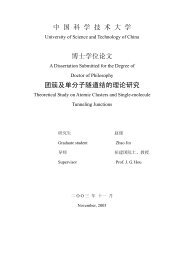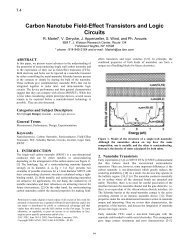Coulomb Blockade and 'Orthodox' Theory of Single-electron Device
Coulomb Blockade and 'Orthodox' Theory of Single-electron Device
Coulomb Blockade and 'Orthodox' Theory of Single-electron Device
Create successful ePaper yourself
Turn your PDF publications into a flip-book with our unique Google optimized e-Paper software.
<strong>Coulomb</strong> <strong>Blockade</strong> <strong>and</strong><br />
<strong>Coulomb</strong> staircase<br />
Zhang Jun<br />
01/06/2004
Introduction<br />
<strong>Single</strong>-<strong>electron</strong> effect in mesoscopics<br />
world<br />
Dimension less than ~30nm<br />
Main component <strong>of</strong> single-<strong>electron</strong>ics:<br />
tunnel junction with a very small<br />
capacitance <strong>and</strong> a resistance
Realization <strong>of</strong> these<br />
junctions<br />
Metal-insulator-metal structure<br />
GaAs quantum dots<br />
Silicon structures<br />
Large molecules with conducting cores
<strong>Coulomb</strong> isl<strong>and</strong>
Change <strong>of</strong> voltage<br />
across the junction<br />
The tunneling <strong>of</strong> only one <strong>electron</strong> may<br />
produce a noticeable change e/C <strong>of</strong> the<br />
voltage across the junction.<br />
<strong>Coulomb</strong> blockade: suppression <strong>of</strong><br />
tunneling at voltages |V|
<strong>Coulomb</strong> blockade<br />
Capacitor charge<br />
Q1=C1*V1<br />
Q2=C2*V2<br />
The charge on the<br />
isl<strong>and</strong>,<br />
Q=Q2-Q1= -ne<br />
n=n1-n2
Voltage drops <strong>of</strong> the<br />
tunneling junction<br />
V1=(C2Va+ne)/Ceq<br />
V2=(C1Va-ne)/Ceq<br />
Ceq=C1+C2
Electrostatic energy<br />
stored in the capacitors<br />
Es=Q 12<br />
/2C 1<br />
+Q 22 /2C 2<br />
Es=(C 1<br />
C 2<br />
Va 2 +Q 2 )/2C eq
The work done by the<br />
voltage source<br />
Ws=∫dtVaI(t)=VaΔQ<br />
One <strong>electron</strong> tunneling through 2<br />
so that n2’=n2+1, n’=n-1, Q’=Q+e,<br />
V1’=V1-e/Ceq, ΔQ = -eC1/Ceq<br />
Result: Ws(n2)=-n2eVaC1/Ceq<br />
Ws(n1)=-n1eVaC2/Ceq
The total energy<br />
E(n1,n2)<br />
=Es-Ws<br />
=(C 1<br />
C 2<br />
Va 2 +Q 2 )/2C eq<br />
+eVa(C1n2+C2n1)/Ceq
The change in energy <strong>of</strong><br />
the system with a<br />
particle tunneling<br />
ΔE 2+ =E(n 1<br />
,n 2<br />
)-E(n 1<br />
,n 2<br />
-1)<br />
=Q 2 /2Ceq-(Q+e) 2 /2Ceq+eVaC 1<br />
/Ceq<br />
=e/Ceq[-e/2+(en+VaC 1<br />
)]
When the isl<strong>and</strong> is<br />
initially neutral (n=0)<br />
ΔE2= -e 2 /2Ceq+eVaC1/Ceq >0<br />
For C1=C2=C, the requirement<br />
becomes simply |Va|>e/Ceq
B<strong>and</strong> diagram
<strong>Coulomb</strong> staircase
Thank You!






